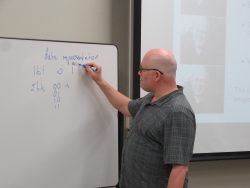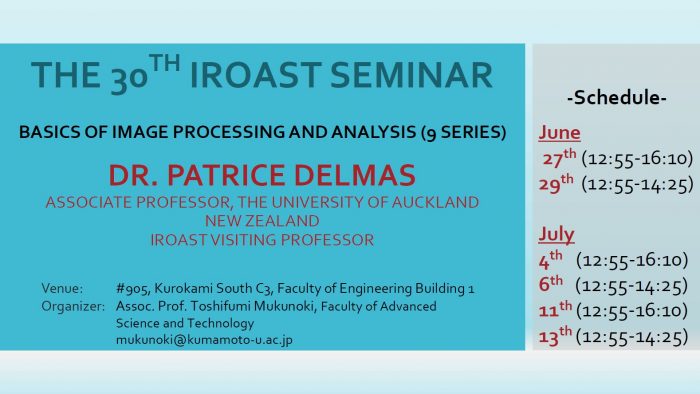- HOME
- SYMPOSIUM & SEMINAR
- 30th IROAST Seminar-Basics of Image Processing and Analysis (9 series)
SYMPOSIUM & SEMINAR
30th IROAST Seminar-Basics of Image Processing and Analysis (9 series) ended on July 13, 2018
The 30th IROAST Seminar, organized by Associate Professor Toshifumi Mukunoki from the Faculty of Advanced Science and Technology, ended on July 13. IROAST Visiting Professor Patrice Delmas, from the University of Auckland, New Zealand, gave talks on "Basics of Image Processing and Analysis." The seminar included 9 classes between June 27 and July 13. He provided students and academics introductory and medium difficulty level image processing knowledge related to the processes required to analyse CT-scan images. About 20 faculty members and students attended the seminar and listened attentively.
 |
 |
30th IROAST Seminar-Basics of Image Processing and Analysis (9 series)
There will be the 30th IROAST Seminar–Basics of Image Processing and Analysis (9 series), starting on June 27, 2018. IROAST Visiting Professor Patrice Delmas from the University of Auckland, New Zealand, will give lectures to students and anyone interested. Please see the poster and abstract below. We hope to see you at the seminar.

Abstract
Over the course of 9 hours class, Prof. Delmas will provide students and academics introductory and medium difficulty level image processing knowledge related to the processes required to analyse CT-scan images. Formally Prof. Delmas will first introduce main image related notions and simple descriptors, such as, normed histograms of pixel/voxel-wise signals or their pairwise co-occurrences. He will then focus on adjusting visual appearance (in terms of integral brightness and contrast) to normalise an image and make it invariant to a few unessential signal deviations. One of the most popular processing tools, namely, a moving-window filtering to suppress some types of image noise and estimate local, or window-wide statistical signal features will be introduced. Examples such as linear mean and Gaussian filters, non-linear median and more general rank filters will be provided. Prof. Delmas will follow with two simple techniques for image segmentation: Building a binary region map by pixel-wise classification, or thresholding signal values after analysing their histogram. He will conclude with some basic morphological moving-window filtering to modify shapes of objects in a binary region map. ImageJ will be used as a support teaching tool throughout the class.

